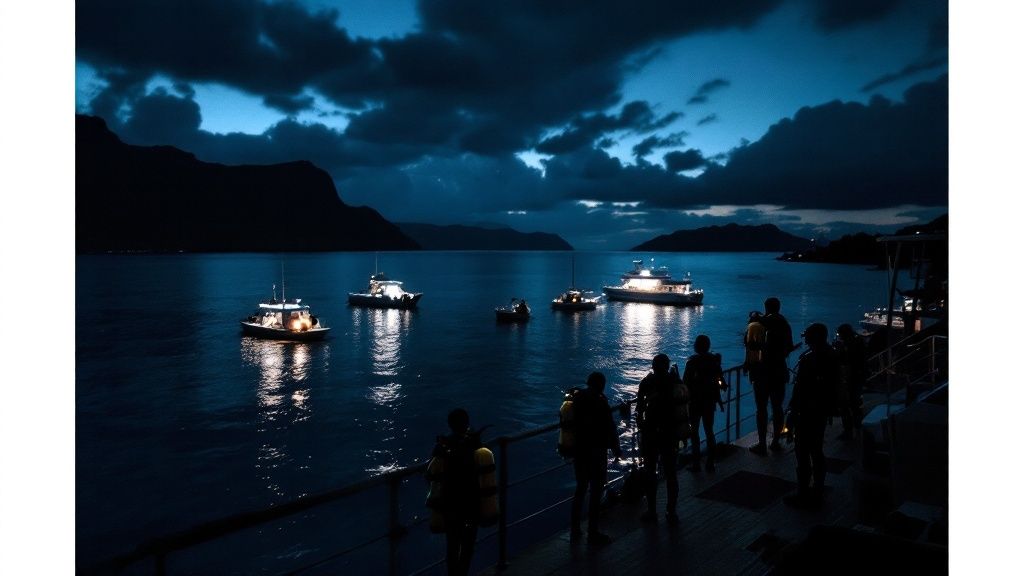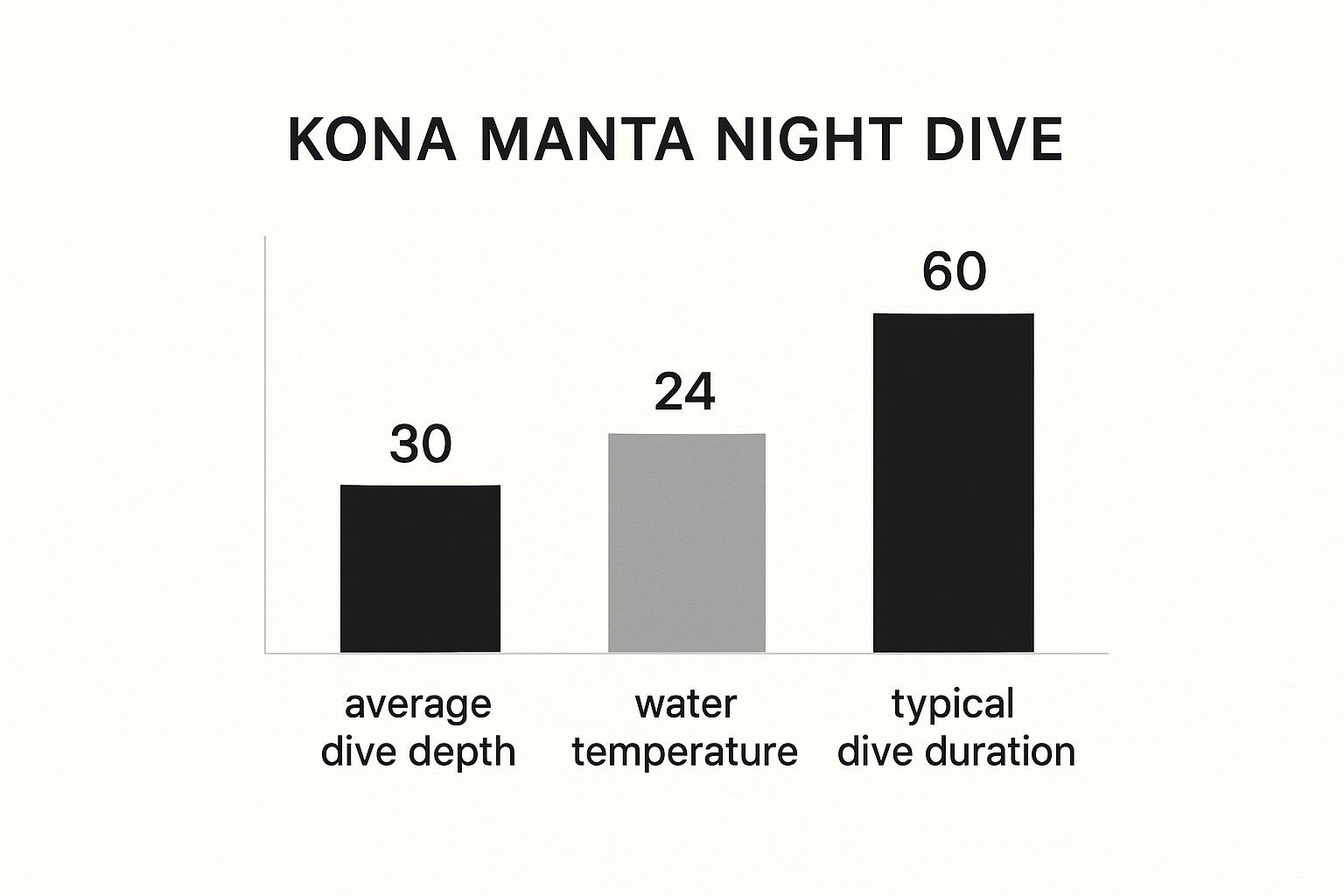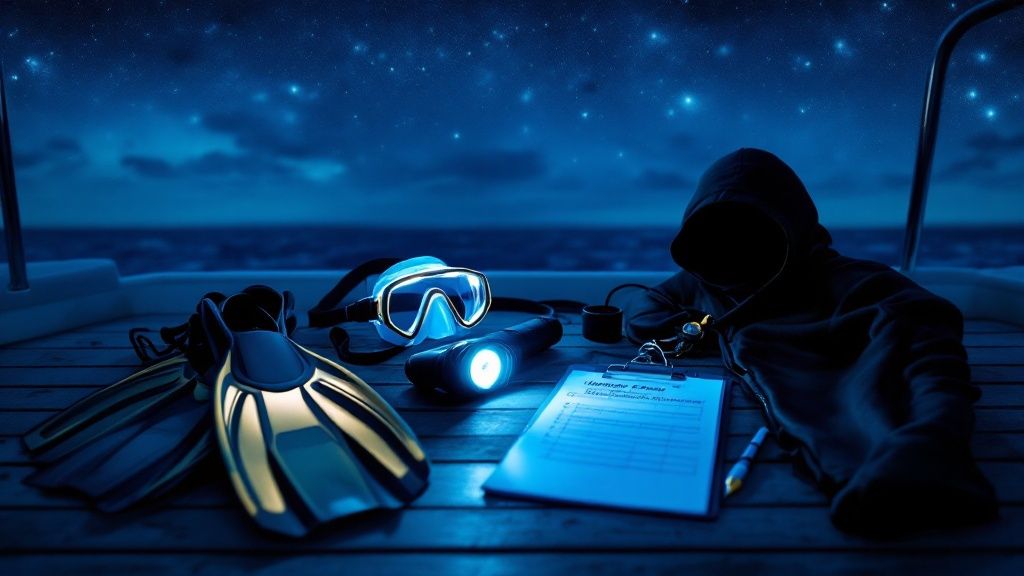The Magic of Manta Dive Kona: Why It Tops Bucket Lists
The Kona Coast offers a truly unique manta ray experience, distinguishing it from other global destinations. What makes a manta dive in Kona so special? It's the remarkable combination of factors that create an almost surreal encounter. The predictable manta ray behavior, along with exceptional water clarity, provides a fantastic opportunity to witness these gentle giants up close. Established marine protocols ensure ethical and responsible interactions, minimizing disruption to these magnificent creatures.
This means divers can expect consistent, high-quality interactions. Imagine the breathtaking view of a 16-foot wingspan gracefully gliding mere inches from your mask. These are the unforgettable experiences often described as life-changing. Intrigued? Find out more: Why you should go on a manta ray dive in Kona.
Why Kona Stands Out
Many locations offer manta ray dives, but Kona sets the standard. Other popular destinations often center on “cleaning stations,” where mantas congregate for parasite removal. While interesting, this experience is far less compelling than observing the dynamic feeding behavior unique to a Kona manta dive.
Moreover, the Kona Coast boasts remarkably high sighting rates. The Kona Coast of Hawaii is world-renowned for its manta ray night dives and offers some of the most reliable sightings globally. Manta rays frequent popular dive sites like Manta Village and Manta Heaven six to seven nights a week. The sighting success rate averages between 85% to 90%, ensuring a very high probability of an encounter. More detailed statistics are available. This reliability, combined with the sheer size and grace of the mantas, solidifies Kona's reputation as a must-visit destination for divers.
Capturing the Magic: Photography Tips
Exploring the Big Island naturally leads to capturing its stunning scenery. Learn more about drone photography. However, underwater photography presents its own unique set of challenges and rewards. The clear Kona waters provide an excellent setting for capturing stunning manta ray images.
Planning your dive should include considering specialized camera equipment and techniques. This will help you maximize your photographic opportunities, preserve memories of your encounter, and share the magic of the Kona manta dive. These images can also be a powerful way to promote manta ray conservation.
Decoding Kona's Manta Phenomenon: Science Behind the Magic

The magical dance of manta rays in Kona's waters is more than just a beautiful sight. It's a complex interplay of fascinating scientific factors creating an ecosystem that consistently attracts these gentle giants. This makes the Kona manta ray dive a world-renowned experience. One key element is the underwater topography, which plays a vital role in plankton concentration. This, in turn, influences manta ray feeding behavior.
Plankton: The Foundation of the Feast
The main reason mantas are drawn to Kona is the abundance of plankton. This microscopic life thrives in the nutrient-rich currents flowing along the Kona coast. These currents, combined with the island's volcanic slopes, create upwellings. These upwellings bring nutrient-rich water to the surface, creating a consistent food source for plankton, which, in turn, attracts the plankton-feeding manta rays.
The relatively shallow depth of popular manta dive sites also allows ample light penetration. This further boosts plankton growth, creating the perfect feeding ground for the manta rays.
The Role of Light and Feeding Strategies
Another captivating aspect of the Kona manta ray dive is the interplay between dive lights and manta feeding strategies. The lights used during night dives attract even more plankton, creating a concentrated feast for the mantas. Manta rays have evolved specialized cephalic lobes that help funnel this plankton-rich water into their mouths.
Combined with their acrobatic feeding behaviors, this creates a stunning display for divers observing from below. Interested in learning more? Check out this article: What is a manta ray night dive?.
Manta Cognition and Social Dynamics
Recent research into manta ray cognition and social dynamics is revealing fascinating insights. Some studies indicate that mantas may recognize individual divers and even develop site preferences. This adds another layer of intrigue to the already remarkable Kona manta ray dive experience.
In 2013, a statistical report documented manta ray sightings in Kona, identifying the top 20 most frequently sighted individuals. Find more detailed statistics here. This long-term monitoring helps researchers understand individual manta ray behavior and movement patterns.
Influence of Natural Cycles
Natural cycles like moonlight, tidal patterns, and seasonal variations also influence manta ray behavior and the quality of dive encounters. The moon's brightness can affect plankton distribution, influencing where mantas feed. Similarly, tidal currents can impact nutrient upwelling and plankton density.
Understanding these intricate relationships gives us a deeper appreciation for the research techniques used to study and protect these magnificent creatures.
Crafting Your Perfect Manta Dive Kona Experience
Planning your dream manta ray dive in Kona requires careful consideration. This includes choosing the right time of year, selecting between the different dive sites, and partnering with operators dedicated to sustainable practices. Let's explore how to create an unforgettable experience.
Choosing the Right Time and Place
The ideal time for your Kona manta ray dive depends on a number of factors. Mantas grace these waters year-round, but certain seasons and moon phases influence their behavior. Experts suggest that moonlight affects plankton visibility, which in turn affects manta feeding patterns. Hawaii's peak tourist season also impacts booking availability, so planning ahead is a must.
Kona offers two primary dive sites: Manta Village and Manta Heaven. Both offer incredible encounters, but they differ in depth, currents, and typical manta activity. Manta Village, nestled in Keauhou Bay, is known for its calm waters, making it perfect for beginners. Manta Heaven, closer to the airport, boasts a larger viewing area and often attracts larger numbers of mantas, appealing to more experienced divers.
To help you visualize the differences, here's a handy comparison table:
Manta Dive Kona: Site Comparison
| Features | Manta Village (Keauhou Bay) | Manta Heaven (Garden Eel Cove) |
|---|---|---|
| Experience Level | Beginner-friendly | Suitable for all levels, favored by experienced divers |
| Water Conditions | Calm, shallow waters | Deeper waters, potential for mild currents |
| Manta Activity | Consistent sightings | Potential for larger groups of mantas |
| Location | Keauhou Bay | Near Kona International Airport |
| Accessibility | Easier access from shore | Boat access required |
This table highlights the key distinctions between the two sites, allowing you to choose the location best suited to your experience and preferences. Whether you’re a novice or a seasoned diver, Kona offers a perfect spot for your manta ray encounter.
Preparing for Your Dive
Whether you're a seasoned diver or prefer to snorkel, proper preparation will enhance your Kona manta ray adventure. Physically, ensure you're comfortable in the water and familiar with basic diving or snorkeling techniques. Mentally, preparing for the unique experience of a night dive can ease any anxieties.

The infographic above provides key metrics for a typical manta night dive in Kona. The average dive depth is a comfortable 30 ft, with a pleasant water temperature of 24°C (75°F). The typical 60-minute dive duration provides ample time to observe these graceful creatures.
Specialized equipment, like underwater cameras, can capture breathtaking images without disturbing the mantas. For non-divers, snorkeling provides an equally magical way to witness these gentle giants. Snorkeling preparation includes choosing appropriate gear and understanding responsible interaction with the mantas.
Finding the Right Operator
Choosing a reputable operator is essential for a safe and enriching manta ray dive experience in Kona. Look for operators who prioritize sustainable practices, adhere to responsible interaction guidelines, and support manta ray research and conservation. Learn more about manta ray dives with Kona Honu Divers.
Experienced dive masters provide thorough briefings on dive procedures, manta ray behavior, and underwater etiquette. This knowledge not only enhances your safety but also deepens your understanding of this unique marine environment. By choosing responsible operators, you contribute to the long-term protection of these magnificent creatures and their habitat, ensuring future generations can experience the magic of a Kona manta ray dive.
Into The Night: The Manta Dive Kona Experience Unveiled

The Kona manta ray night dive is an experience that begins long before you even touch the water. It starts with the anticipation of a sunset boat ride, the pre-dive briefing on shore, and the palpable excitement as darkness descends. Let's explore a typical manta night dive step-by-step, from initial preparations to that magical first encounter.
Setting The Stage: Preparation and Descent
The adventure begins with a comprehensive briefing on land. Dive masters outline the dive plan, emphasizing safety procedures and responsible interaction with the manta rays. This includes important information about lighting techniques and how to position yourself for optimal viewing without disturbing the mantas. You might find this helpful: Manta Ray Night Dive of Kona. Next, you'll enjoy a relaxing boat ride as the sun sets, painting the sky with breathtaking colors. The anticipation builds as you approach the dive site. Finally, you arrive and make your final dive preparations.
The initial descent into the dark ocean can be a unique sensation, even for experienced divers. However, dive masters use specialized techniques to create a comfortable and safe environment. They often use a fixed anchor line and pre-placed lights on the ocean floor to guide divers to a designated viewing area.
The Manta Ballet: Awe-Inspiring Encounters
As you settle on the ocean floor, the true magic unfolds. Dive lights, strategically positioned to attract plankton, create an ethereal glow. Soon, the majestic manta rays appear, drawn by the promise of a plankton feast. These gentle giants, with wingspans reaching up to 16 feet, perform an underwater ballet, gracefully gliding and looping through the illuminated water. They execute intricate barrel rolls and backflips as they feed, a truly captivating spectacle. Being this close, often mere inches from your mask, is an unforgettable moment that will stay with you long after you resurface.
Addressing Common Concerns: Safety and Comfort
Many people experience some anxiety about night diving, especially with large marine life like manta rays. However, these concerns are usually unfounded. Manta rays are filter feeders, their diet consisting solely of tiny plankton. Despite their impressive size, they are harmless to humans. Experienced guides are skilled at easing any apprehension, explaining manta ray behavior and emphasizing their gentle nature.
Furthermore, Kona manta dive operators adhere to strict safety protocols. The manta ray encounters on the Kona Coast support a significant tourism industry, with approximately 80,000 divers and snorkelers participating annually. This highlights Kona's global appeal as a top destination for marine wildlife encounters. Learn more about this topic.
Manta Etiquette: Respecting The Gentle Giants
Understanding manta ray behavior and following proper underwater etiquette ensures these incredible encounters remain positive for both humans and the mantas. Dive masters provide guidance on how to avoid disrupting the manta rays' natural feeding habits. This includes maintaining a respectful distance, never attempting to touch them, and carefully managing your buoyancy to prevent accidental contact with the ocean floor or the mantas.
By following these guidelines, divers can witness the breathtaking beauty of manta rays in their natural habitat while contributing to their long-term well-being. This responsible approach ensures future generations can also experience the wonder of a Kona manta ray dive.
Beyond Entertainment: How Your Manta Dive Protects These Giants
Your manta ray dive in Kona isn't just an unforgettable experience; it's a direct contribution to these gentle giants' conservation. In Hawaii, tourism, research, and manta ray protection intersect in remarkable ways. The visitor fees from your dive directly support vital conservation work by leading marine organizations.
These organizations utilize the funds for a variety of initiatives. These include tracking technologies, habitat protection, and community education programs. All these efforts contribute to the well-being of manta ray populations.
Understanding the Threats and Mitigation Efforts
Hawaiian manta rays face several threats. Entanglement in fishing gear and habitat degradation are two of the most significant challenges. Fortunately, responsible tourism plays a vital role in mitigating these risks. By choosing reputable operators and participating in eco-friendly tours, you directly support sustainable practices that protect the mantas and their environment. For a top-tier experience, consider the Best Manta Ray Night Snorkel Kona. Learn even more here.
Citizen Science: Contributing to Research
Many manta dive operators in Kona incorporate citizen science into their tours. This means you can contribute valuable data to researchers while enjoying your dive. You might be asked to help identify individual manta rays based on their unique markings. Or perhaps you'll record observations about their behavior. This data combined with information from other divers and scientists provides a more complete understanding of manta ray ecology, informing conservation strategies.
To help illustrate the impact of tourism on manta ray conservation, let's look at some specific examples.
Manta Ray Conservation Impact
This table presents key statistics about manta ray conservation efforts in Kona and how tourism contributes to protection initiatives.
| Conservation Metric | Value/Impact | How Tourists Contribute |
|---|---|---|
| Funding for Research | $X annually (estimated) | Direct contributions from dive tour fees support research projects. |
| Number of Identified Mantas | Over X individual mantas cataloged | Citizen scientists help identify and track individual mantas, aiding population studies. |
| Protected Habitat Area | X square miles of crucial manta ray habitat designated as protected zones | Tourism revenue supports the establishment and maintenance of these protected areas. |
| Community Education Programs | X programs reaching X people annually | Dive operators often conduct educational sessions, raising awareness about manta ray conservation. |
Note: Replace X with the real, relevant values
The table clearly shows how tourism dollars translate into tangible conservation outcomes. From funding crucial research to expanding protected habitats, visitor contributions play a vital role.
Choosing Responsible Operators: Maximizing Your Impact
Choosing the right operator is key to maximizing your positive impact. Look for operators actively involved in conservation efforts and adhering to strict guidelines for responsible manta ray interactions. These guidelines often include maintaining a respectful distance, avoiding touching the mantas, and minimizing disruption to their natural feeding behaviors.
Practical Tips for Sustainable Diving
Beyond choosing responsible operators, here are some practical ways to minimize your environmental footprint and maximize your contribution to manta ray protection:
- Proper Buoyancy Control: Good buoyancy prevents accidental contact with the reef or the mantas.
- Reef-Safe Sunscreen: Choose sunscreens without chemicals harmful to coral reefs and marine life.
- Reduce Plastic Use: Minimize single-use plastics by bringing your own reusable water bottle.
- Support Local Businesses: Patronizing locally-owned businesses that prioritize sustainability supports the local economy and reinforces responsible practices.
By following these guidelines and choosing operators committed to conservation, you can ensure your Kona manta ray dive is not only unforgettable but also contributes to the long-term health and survival of these magnificent creatures.
Maximizing Your Big Island Adventure Beyond Manta Dives

A manta ray dive in Kona is an unforgettable experience, a highlight for any trip to Hawaii. But limiting your Big Island adventure to just this one activity would be a mistake. The island is brimming with diverse opportunities, from exploring volcanic landscapes to immersing yourself in authentic Hawaiian culture. By carefully planning your itinerary, your manta dive can become the starting point of an extraordinary Hawaiian vacation. Intrigued? Check out what it's like to go on a manta ray dive in Kona, Hawaii.
Exploring Kona's Underwater World
While the manta ray night dive is a must-do, it's just a glimpse into the wonders of Kona's underwater realm. Expand your itinerary to include other dive sites teeming with marine life. Discover hidden coves filled with colorful reef fish, vibrant corals, and maybe even encounter dolphins or unique Hawaiian species.
Depending on the season, you might even be lucky enough to spot migrating humpback whales. These magnificent creatures grace Hawaiian waters during the winter months, offering an awe-inspiring addition to your underwater adventures.
Embracing the Big Island's Terrestrial Wonders
The Big Island's diverse landscapes extend far beyond the ocean's depths. Kilauea volcano, a powerful symbol of the island's volcanic heart, is an absolute must-see. Witnessing the raw energy of volcanic activity is a truly humbling experience.
But the island's beauty doesn't stop there. Discover hidden waterfalls cascading down lush cliffsides, hike through vibrant rainforests filled with unique flora and fauna, and relax on secluded beaches as you watch breathtaking sunsets.
Experiencing Authentic Hawaiian Culture
To truly appreciate the Big Island, immerse yourself in the rich local culture. Venture beyond the typical tourist attractions and seek out authentic experiences. Attend a traditional luau, explore local farmer's markets, or even try a ukulele lesson.
These experiences offer a deeper understanding of Hawaiian traditions and values. Supporting locally-owned accommodations and restaurants not only enriches your cultural immersion but also contributes to the island's economy and allows you to experience true Hawaiian hospitality.
Practical Tips for Planning Your Adventure
Careful planning is key to a smooth and enjoyable Big Island experience. Consider transportation logistics, especially if you're planning on exploring different parts of the island. Renting a car offers the flexibility to explore at your own pace, while public transportation is a more budget-conscious option. However, keep in mind that public transport may require longer travel times.
Think about the best sequence for your activities to maximize your time and minimize travel. For example, try grouping activities on the same side of the island to reduce back-and-forth trips. These practical considerations will ensure your entire Big Island adventure is as memorable and authentic as your manta dive in Kona.
Ready to experience the magic of Kona? Book your unforgettable manta ray night dive and other ocean adventures with Kona Honu Divers today!
